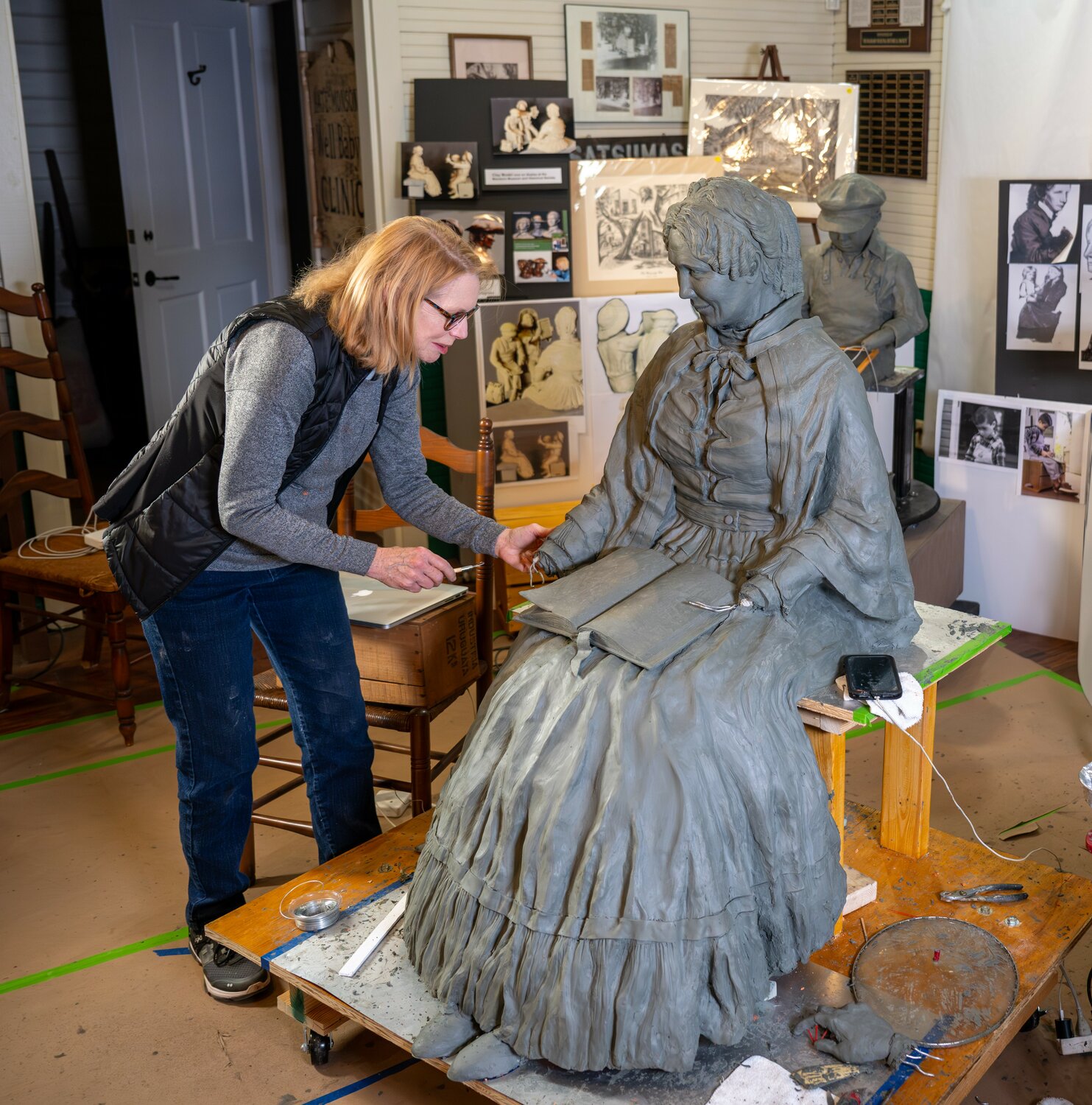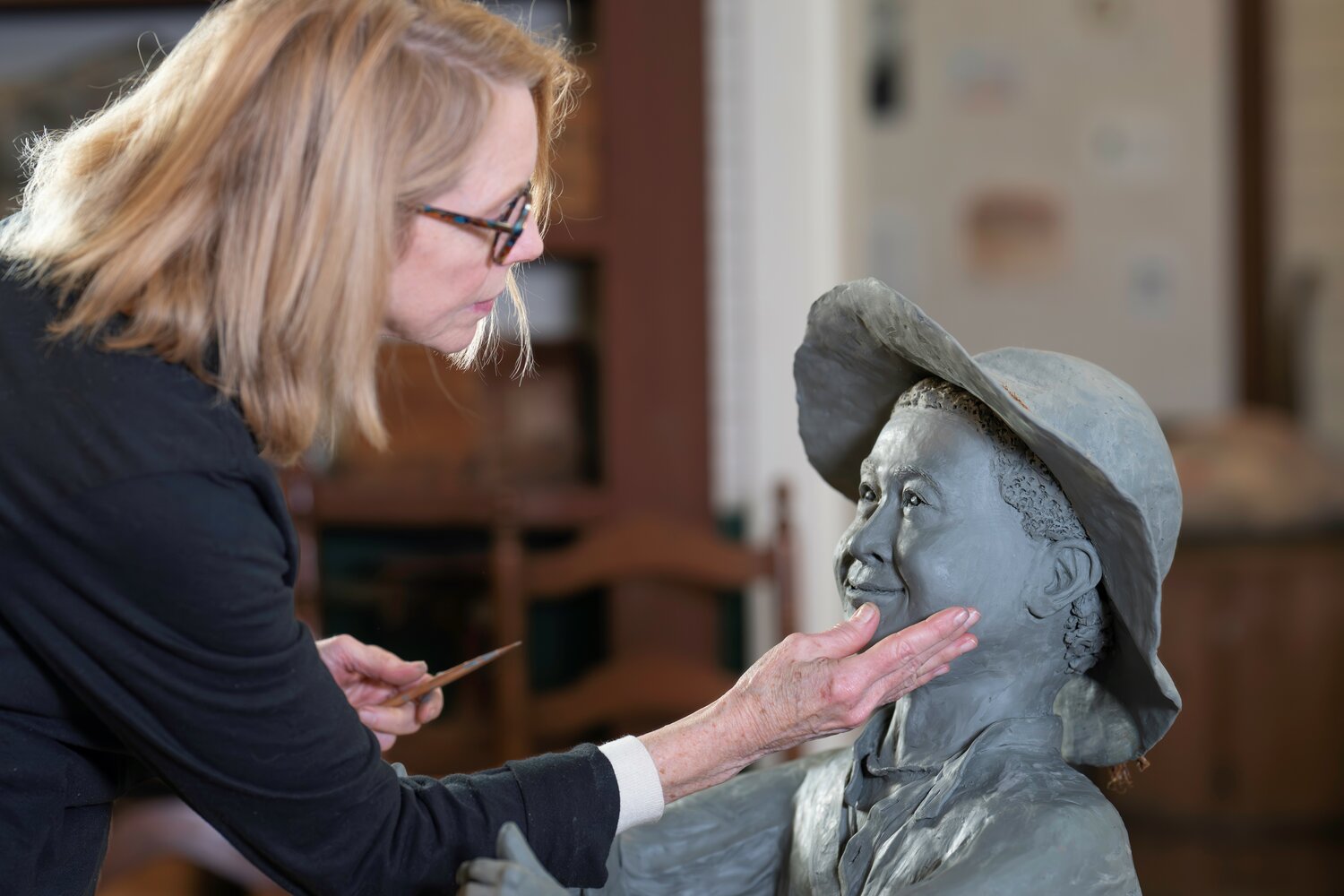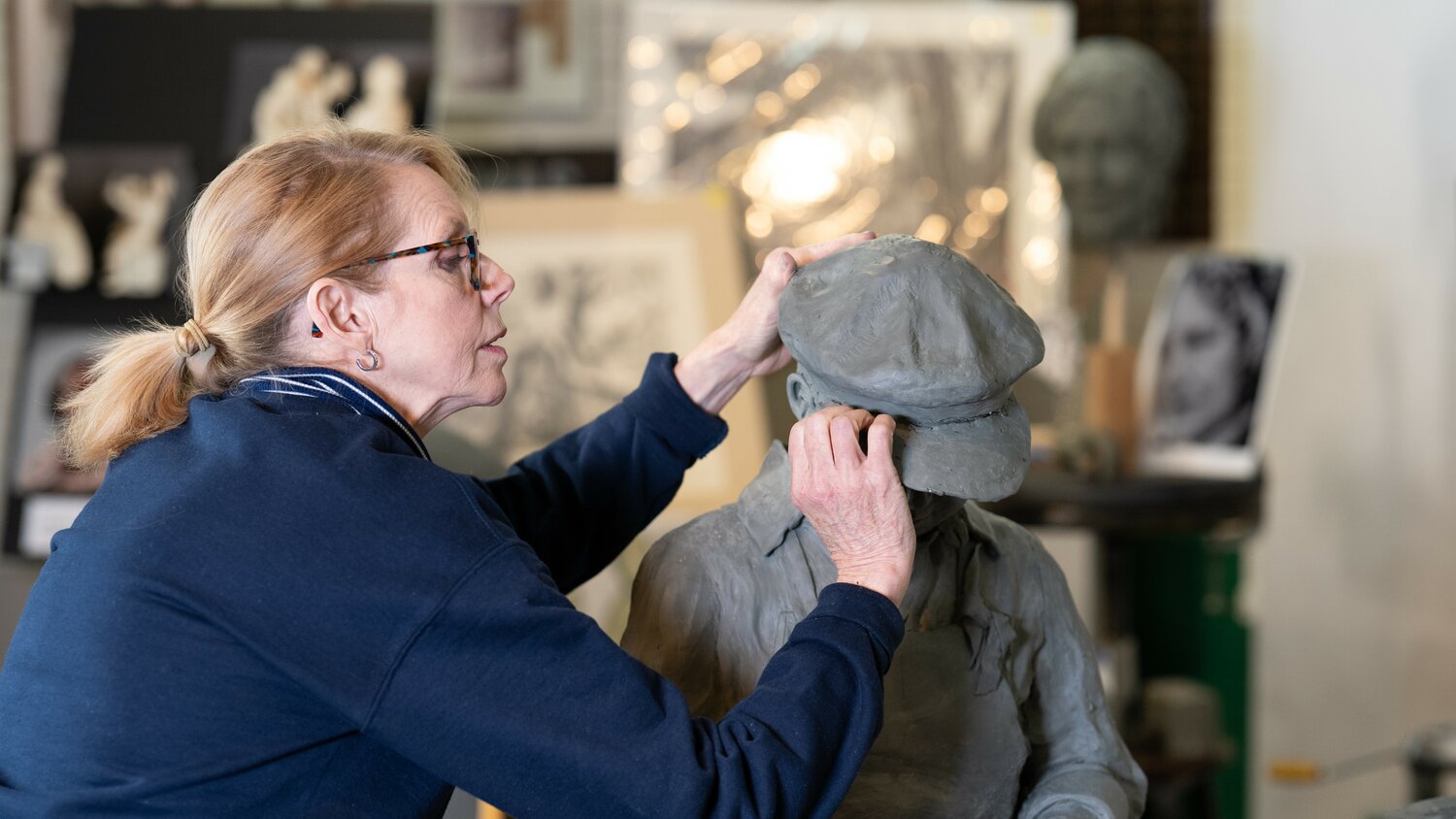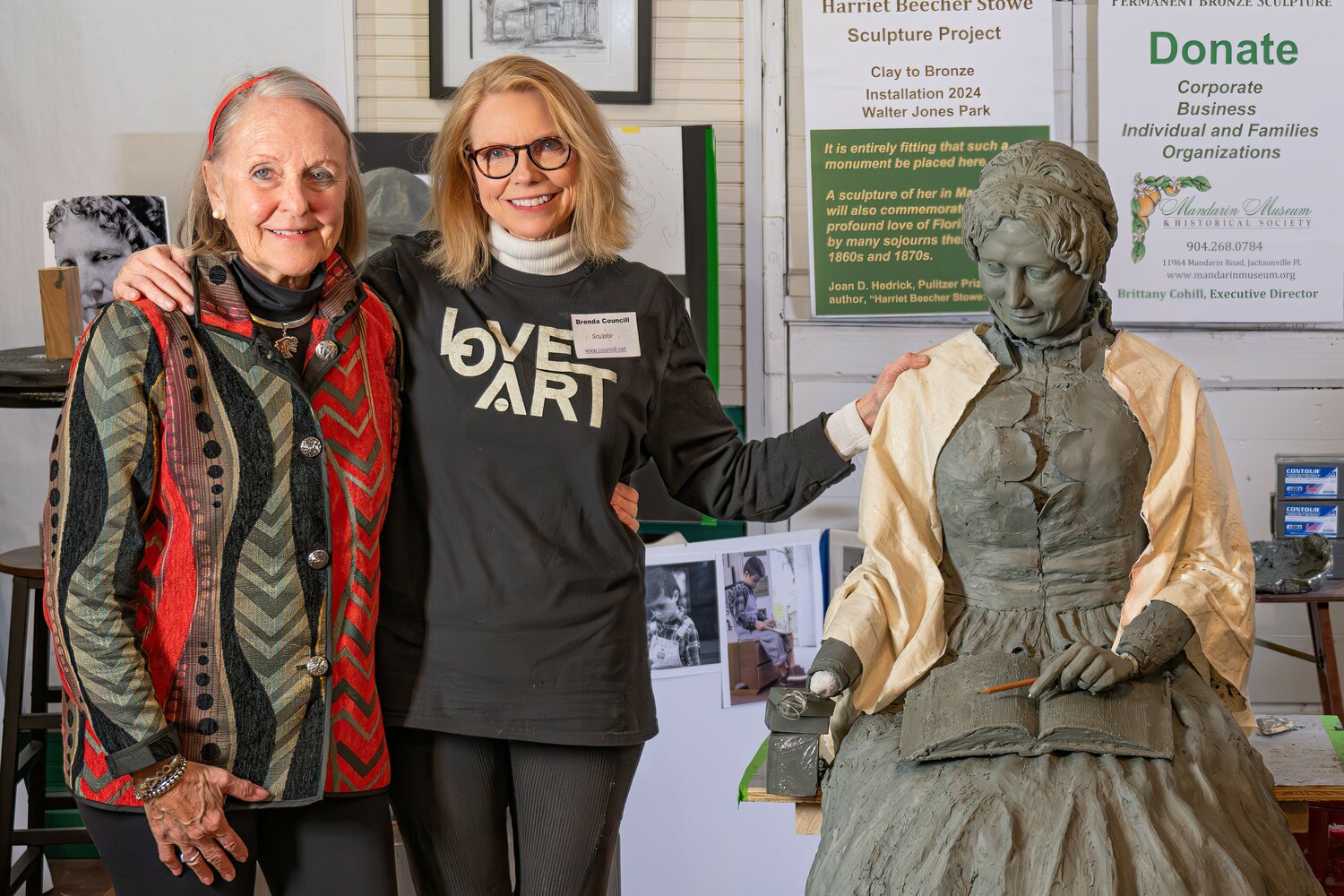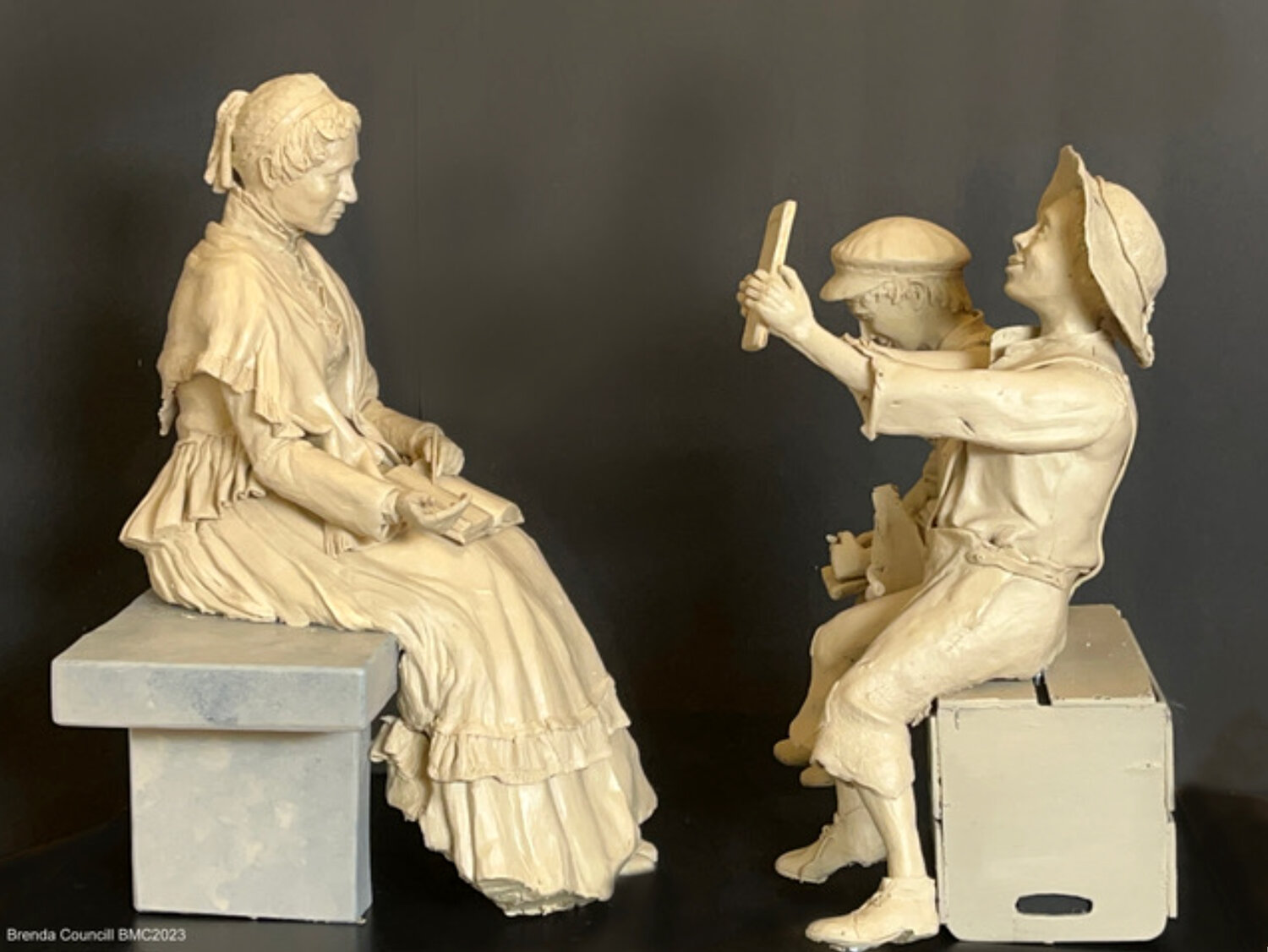Celebrating Harriet Beecher Stowe in Mandarin
Bronze sculpture to commemorate famous resident
Follow Mandarin Road as it winds beneath a Spanish-moss-laden canopy of live oaks and you will come across a small structure, once the general store and post office for the riverside village after which the road is named. It’s here, inside this unassuming building, that an acclaimed artist has been laboring since early December to create a work of artistic and historic significance.
Brenda Mauney Councill, now living in North Carolina, returned to the community where she grew up to create the world’s only life-sized sculpture of one of Florida’s most famous residents: Harriet Beecher Stowe.
Stowe, who first arrived in Mandarin in 1867, spent 17 winters here, and her contributions to this community cannot be overstated.
The sculpture, initially fashioned in clay to be later cast in bronze, depicts three figures: The famous author and abolitionist seated on a bench opposite two boys — one Black, one White — who sit on an overturned orange crate. Stowe points to a page in an open book, teaching her charges their ABCs. One boy inscribes his name on a small slate and the other proudly holds his up for the instructor to see. The students are laborers in the orange groves of Mandarin, and they represent the many children of the community who would have gone uneducated but for Stowe’s work in creating the village’s first school.
When complete, the bronze sculpture, titled “Harriet Beecher Stowe in Mandarin,” will be installed in Walter Jones Historical Park, just up the road. Installation is tentatively set for sometime in the fall.
An inspired project
“I grew up in the Mandarin area, so I always knew about Harriet Beecher Stowe’s legacy here and her work,” said Councill. “I had been thinking about the very fact that a sign on the side of the road and an exhibit at the museum, as great as they are, weren’t enough. I wanted to bring her into a life-sized setting so that people would be encouraged to learn more about her.”
Stowe is best known for her landmark 1852 novel “Uncle Tom’s Cabin,” which educated readers about the evils of slavery and inspired people to put an end to it.
“It changed this country in a profound way,” said Councill. “No other writer has that distinction. That’s why creating this monument to her is so important for Jacksonville and the United States. The whole nation should know her story, and it should be perpetuated generation to generation.”
Councill decided upon the sculpture’s composition after reading Stowe’s 1873 collection of essays regarding her life in Mandarin, “Palmetto Leaves.”
She proposed her idea to the Mandarin Museum & Historical Society and began working on the sculpture on Dec. 8. Over the following two months, Councill worked nonstop, 10 hours a day. On weekends, she welcomed the public to visit the Historic Mandarin Store and Post Office and watch her create the work.
The sculpture, finished in mid-February, has been moved to Seagrove, North Carolina, where a foundry is transforming it into the completed bronze monument.
‘A true servant’s heart’
Harriet Elisabeth Beecher was born June 14, 1811, in Connecticut, the daughter of a prominent minister. She later relocated to Cincinnati, Ohio, where she wrote stories and sketches and, in 1836, married the Rev. Calvin Stowe. The Stowes moved to Maine in 1850, where both were critics of slavery and supporters of the Underground Railroad.
Harriet Beecher Stowe’s famed novel was published two years later, after first being serialized in a newspaper. In its initial year, “Uncle Tom’s Cabin” sold 300,000 copies, ranking second only to the Bible.
After the Civil War, Stowe was in Laurel Grove (later Orange Park) buying some land for her son to farm. She crossed the St. Johns River to pick up her mail and discovered Mandarin, where in 1867 she bought 30 acres of land and moved into a house on the waterfront.
Here, she helped raise the money to build the first Freedmen’s Bureau, which provided clothing, food, medical services and shelter to emancipated African-Americans. She established a school for Black children, purchasing the land herself and hiring the first teacher. She also raised money to build the Church of Our Savior, which had Tiffany windows. (It was rebuilt after the original was destroyed in 1964 in Hurricane Dora.)
“She had a true servant’s heart,” said Councill.
Stowe wintered here through 1884, after which she returned to Connecticut. She died July 1, 1896, in Hartford.
Stowe’s fame lives on today. Recently, the Florida Commission on the Status of Women selected her as a 2023 finalist to be considered for the Florida Women’s Hall of Fame.
Murals and more
Councill is a native of North Carolina but grew up a Floridian after her father, an executive with the Seaboard Coast Line Railroad, was transferred here in 1960.
She had her first art exhibit in 1963 at the age of 7 as a result of lessons she was taking after school at the former Children’s Art Museum (now the Museum of Science and History). She won a competition with her painting of Charles Adrian Pillars’ iconic 1920 bronze sculpture in Memorial Park, “Spiritualized Life and Winged Victory.”
“I’ve painted most of my life,” Councill said, “but that first thing I painted was a sculpture!”
Councill studied art at the University of North Florida and the former Florida Community College at Jacksonville (now FSCJ), ultimately moving to New York in 1987, where she opened a large studio and gallery. She made a name for herself as a painter of ceiling murals, including a large work for the David H. Murdock Core Laboratory Building.
That work prompted television personality Martha Stewart to label her “Michelle-angelo.”
“I transitioned to sculpture about five years ago,” Councill said. It was something she’d actually returned to, having sculpted early in her career. She has also created a bronze sculpture of famed Impressionist Elliott Daingerfield, which is installed in Blowing Rock, North Carolina, where she lives. She’s also been commissioned to create a women’s suffrage monument for the State of Ohio.
From clay to bronze
In creating the sculpture of Harriet Beecher Stowe, Councill took great care with the details. The names etched into the slates held by Stowe’s students were selected from actual genealogical records.
The bench upon which Stowe sits is wide enough so that visitors can sit next to her and have their photos taken.
A photographer and videography have been documenting the progress of the sculpture.
The process Councill uses to create the sculpture is called “lost wax.” She makes the sculpture from an oil-based clay. This is sent to the foundry, where a rubber mold is made. Wax is poured into that mold, which is then peeled away, revealing a perfect replica of the clay original.
A ceramic mold is made around the wax version. After that hardens, molten bronze is poured in, displacing the wax and filling every crevice. When that second mold is broken away, the bronze sculpture is revealed. It’s polished and a special patina is added.
“This will last for thousands of years,” said Councill. “That’s why we chose bronze as the element for this sculpture. We want it to outlast us for many generations.”
The project has the approval of the City of Jacksonville and the Florida Communities Trust. It has also won the endorsement of Joan D. Hedrick, the author of the 1995 Pulitzer Prize-winning biography, “Harriet Beecher Stowe: A Life.”
“It is entirely fitting that such a monument be placed there,” Hedrick stated. “It will celebrate one of America’s most prolific and influential writers … [and] commemorate Stowe’s profound love of Florida.”
Seeking support
The creation of such a large bronze sculpture is not an inexpensive endeavor, and the museum welcomes donations. It hopes to raise $150,000 to fund the project.
Donors at the $2,500 level and above will be recognized on a permanent plaque located near the sculpture and will be invited to a private cocktail reception.
Anyone interested in making a donation can find more information at mandarinmuseum.org. They can also contact Executive Director Brittany Cohill at 904-268-0784 or director@mandarinmuseum.org.
To learn more about the artist, go to councill.net.


